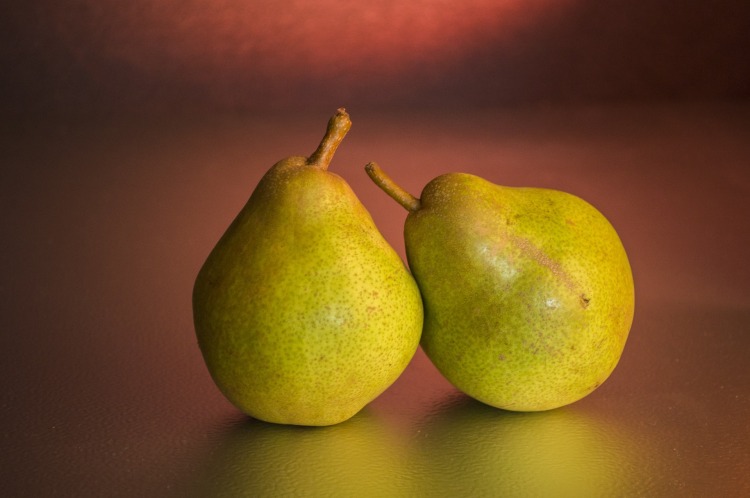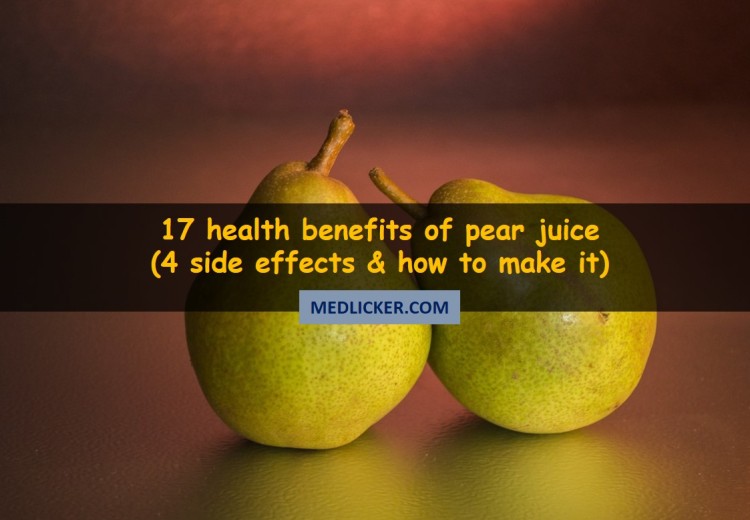17 Great Benefits of Pear Juice
Pear juice has lots of benefits. Not only it helps deal with high blood pressure and cholesterol but it also promotes bone health, contains a lot of potassium and is a powerful antioxidant. This post features a detailed and evidence based look at the benefits (and adverse effects) of pear juice. You will also learn about how to make pear juice and find out about its nutritional values.
About pear juice and pear fruit
Pear juice is derived from the pear fruit. The pear is one of any shrub species of the genus Pyrus in the family Rosaceae. The fruit of the trees is also known as pear. Many species of pear fruit are used for their edible qualities whereas some are used as ornamental trees.
Taxonomy
The English word “pear” is derived from the Common West Germanic “pera” which is a loan word of Vulgar Latin ‘pira’, the plural of ‘pirmum’ and has a sematic origin. The place called “pera” indicates the historical significance of these trees. The term “pyriform” is used to describe anything which is pear shaped (1).
Description
The pear fruit is mostly found in temperate and coastal regions of the world from North Africa East and Western Europe to Asia. The pear tree is medium sized and reaches to about 10 to 17 meters tall and has a tall and narrow crown; a few species are also shrubby.

The leaves of the fruit are arranged alternately and are simple with length of 2 to 12 centimeters; some leaves are glossy green whereas others are moresilvery-hairy than others. The leaves have shapes from broad oval to narrow lanceolate. Many species are deciduous but some are evergreen. They are cold and can tolerate temperatures between -25 and -45 degrees Celsius in winter. But the evergreen species can tolerate temperatures only up to -15 degrees Celsius.
The flowers are white and rarely, pink and yellow. They are 2 to 4 cm in diameter and have five petals. The pear fruit is about 1 to 4 cm in diameter but some cultivated species are about 18 cm long and 8 cm broad and shape varies from globose (like a globe) to classic pyriform (pear-shape).
The pear fruit is made up of the rectangular or upper part of the flower-stalk. There are about five cartilaginous carpels called “core” in the flesh of the fruit. There are also five sepals, five petals and numerous stamens present around the fruit.
Cultivation
There are more than 3000 different varieties of pear known worldwide. The pear fruit is normally cultivated by grafting a certain variety on the rootstock. Quince rootstocks produce smaller trees which are used in domestic gardens. The flowers can be cross-bred to produce new varieties and desirable traits. The fruit of the pear is usually produced on the spurs which appear on the shoots more than one year old.
The three species which are known for the majority of the edible fruit production are the European Pear Pyrus Communis subsp cultivated in Europe and North America, the Nashi pear Pyrus pyriflolia grown mainly in East Asia and the Chinese white pear Pyrus betschneideri. Many cultivars of these species are present throughout the world. Two other popular grown species are P. pashia grown in southern China and P. sinkiangensis grown in South Asia.
History
There are many ongoing debates about the exact origin of the pear fruit but experts agree that the European and Asian pear originated separately but roughly around the same time in history. Many species of pear are also present in parts of Africa.
The pears were first of all cultivated by the Romans who ate the fruit raw of cooked like apples. They also mixed it with honey and cultivated about three dozen varieties. The Roman cookbook known as “Apicius, De re coquinaria” has a recipe for spiced, stewed-pear patina or soufflé. A specific race of pear with white down on the surface seems to be originated from P. nivalis and the fruit is mainly used in France in manufacturing of perry (the alcoholic beverage made from pear).
Pear originated in the modern world in 1500 when the European colonists brought pear to North America where they weren’t enjoyed before that time. Pears were cultivated in those regions but the colonists continued to bring them from other parts of Europe and France. Pears have now become a small part of the U.S. diet. The U.S. produces about 75,000 metric tons every year but still large varieties are obtained from Chile, China, Argentina, New Zealand and South Korea.
Nutritional values of pear juice
The pear juice is quite a nutritious juice mainly because of the nutrients present in the pear fruit. The following table gives you a brief overview about the nutritional value of pear juice (2):
| Serving size: 1 bottle | ||
|---|---|---|
| Amount per serving | ||
| Calories | 58 | |
| % daily value | ||
| Total fat | 0 g | 0 |
| Saturated fat | 0 g | 0 |
| Trans fat | 0 g | 0 |
| Cholesterol | 0 g | 0 |
| Sodium | 0 g | 0 |
| Potassium | 162.5 mg | 5 |
| Total carbohydrate | 14.8 g | 5 |
| Dietary fiber | 0.1 g | 1 |
| Sugar | 9.1 g | |
| Protein | 0 g | 0 |
| Vitamin A | 0 | |
| Vitamin C | 70 | |
| Calcium | 2 | |
| Iron | 0 | |
| Thiamin | 1 | |
| Riboflavin | 2 | |
| Vitamin B6 | 1 | |
| Niacin | 2 | |
| Magnesium | 3 | |
| Phosphorus | 2 | |
| Zinc | 1 | |
| Copper | 4 |
Health benefits of pear juice
There are a number of health benefits of pear juice. Some major health benefits of pear juice include the ability to facilitate weight loss, improve digestion, regulate the body’s fluid levels, improve heart health, increase cognition, reduce blood pressure, promote heal wounding and tissue repair, defend against birth defects, reduce inflammation, boost immunity, improve circulation, increase metabolism and protecting against osteoporosis.
The detailed description of health benefits of pear juice is provided below:
1. Digestive and intestinal health
The pear juice has quite an important role in digestion. A single glass of pear juice provides about 18% of the daily requirement of fiber intake and they are a strong agent for digestive health and function (3). The majority of fiber in pear is non-soluble polysaccharide meaning that it acts as a bulking agent in the intestines. It gathers the food and adds bulk to it so that it can easily pass through the intestines. It also stimulates the secretion of gastric and digestive juices so that the food moves smoother in a digested state.
It keeps the bowel movement under control and reduces the chances of constipation; it also prevents diarrhea and loose stool because it adds bulk to the bowel movements. The pear juice also binds itself to the cancer-causing and free radicals in the colon and protects the organ from damaging effects.
The pear juices have 6.5% fructose and 1.3% sucrose (4). Free fructose isn’t absorbed properly and escapes its absorption in the small intestines and becomes fermented in the large intestines. This results in the production of SCFA (Short chained fatty acid) which leads to the absorption of a small energy in the colon. This explains why pear juices are used in the treatment of constipation (5).
2. Low caloric content
The common complaint that people have about other fruit juice is the high caloric content in them which is obtained from natural sugars. But pears are among the lowest caloric foods. An average pear juice contains just about 58 calories (one glass) (2). But the nutrition provided by pears is quite immense and it gives you a feeling of satiety. So people looking to lose weight should add pears to their diet. It is a high-energy and high-nutrient food with low impact on weight gain.
3. Antioxidant activity
Pears have a good amount of antioxidants in them like other fruits which are helpful in fighting various diseases and illnesses in the body. Antioxidants eliminate the free radicals which gather in the body by cellular metabolism. These free radicals change healthy DNA into cancerous cells which can have a devastating effect. So the antioxidant components of Vitamin C, Vitamin A, and beta-carotene which are found in pear juice can help the body get rid of dangerous diseases (6, 7).
4. Healthy immune system
The immune system of the body is boosted by vitamin C in the body. Vitamin C is quite beneficial for the immune system because it stimulates the production of white blood cells. Fruits like pear are mostly used to eliminate the simple conditions like flu, common cold, and other simple diseases which a boosted immune system can cure (8).
5. Cancer prevention
A major health benefit of pear juice is the prevention of cancer. The fibers from pear juice can bind themselves with bile acids and a special group of bile acids known as secondary bile acids. High amounts of secondary bile acids in our intestines increase the risk of colorectal cancer.

The fibers in pear decrease their concentration in the intestine and lower the risk of development of cancer. The intake of pear juice also reduces the risk of stomach cancer. Different key components in fiber phytonutrients and cinnamic acids like ferulic acid and coumaric acid have cancer fighting properties. A recent study conducted in Mexico City showed that 2 total fruit servings of pear can create a decrease in gastric cancer risk (9).
Esophageal cancer is also a dangerous type of cancer but pear juice can reduce its risk and effect. A large scale study was conducted by the National Institute of Health and American Association of Retired persons, which found that pear was a key food which reduced the risk of ESCC (esophageal cancer) (10).
6. Potassium content
Pear juice is a good source of potassium; this means it has a significant impact on heart health. The reason is that potassium is a good vasodilator (opens the blood vessels) (11). It lowers the blood pressure and reduces the strain on cardiovascular system and thus stops the formation of clots. It also increases the blood flow to all parts of the body which oxygenates the organs and improves their functioning. Low blood pressure leads to lower chances of different cardiovascular diseases like atherosclerosis, strokes and heart attacks. Potassium also functions as a fluid regulator in the body and keeps different organs hydrated and ensures the balance of body fluids (12).
7. Healing of wounds
Vitamin C is an essential part of making new tissues in various organs and structures of the body. This controls the body metabolism and ensures that all processes take place smoothly. The healing of wounds is improved with high content of ascorbic acid; so the smaller injuries and diseases are healed faster with high levels of the nutrient in your diet (13). It also helps in repairing the damaged blood vessels which reduces strain on the cardiovascular system and prevents the development of certain heart diseases.
8. Birth defects
Folates are another valuable nutritional components present in pear juice. Research has shown that folic acid is positively correlated with the reduction of neural tube defects in newborns (14). So eating folate can protect the health of a baby. Therefore, pregnant women are encouraged to drink pear juice.
9. Bone health
Pear juices have a high mineral content in them which includes manganese, phosphorous, magnesium, copper and calcium. This means that the effects of bone loss and serious bone conditions like osteoporosis and general weakness of the body are reduced (15).
10. Improved circulation
Pear juice is quite helpful for patients suffering from anemia or other mineral deficiencies because of the high content of copper and iron in it. Copper helps in improving the uptake of minerals in the system and high levels of iron in the body increase the red blood cells synthesis (16). Iron is a good part of hemoglobin. A person can prevent fatigue, muscle weakness and cognitive malfunction by consuming foods with high copper and iron content (17).
11. Reducing inflammation
The flavonoids and antioxidant compounds in pear juice have anti-inflammatory properties and reduce the pain associated with inflammatory diseases. This reduces the symptoms of osteoarthritis, rheumatoid arthritis, gout and other similar conditions (18).
12. Skin, eyes and hair
Vitamin A is one of the most versatile vitamins in the human body. Pears have high vitamin A content and other components like leutin and zea-xanthin. They function as a good antioxidant and participate in a number of enzymatic reactions and reduce the effects of aging on skin. Pear juice also reduces hair loss, cataracts and other health conditions associated with aging (19, 20).
13. For weaning children
Pear juice is quite helpful for weaning children (introducing a young child to an adult’s diet and stopping the supply of mother’s milk). The reason is that it is hypoallergenic and has low acidic fruit (21). So it doesn’t cause any digestion problems. The fruit juice can be served cold to children. Pear juice shouldn’t be given to children with diarrhea.
14. Preventing skin damage
Many different kinds of fibers are present in pear juice which play an important role in keeping the skin soft and smooth (22). They slow down the discharge of sugar into the blood and prevent skin damage from collagen which is caused due to raise in blood sugar. This makes the skin look smoother and active.
15. No allergic reactions
A major benefit of pear juice over other fruit juices is that it has lesser chances of allergies. This is the reason that this fruit juice can even be given to infants and toddlers. However while allergy to pear is not very common, it can be seen sometimes so you need to be careful (23).
16. Keeping wrinkles at bay
You should drink pear juice if you want to stay away from aging. The fruit has high content of Vitmain C, copper and Vitamin K in it. These elements give this fruit juice the ability to fight harmful free radicals and thereby protects the skin cells from damage. Thus it helps in toning of the skin and stop the formation of fine lines near the eyes and lip area (24).
17. Healthy and nourished hair
The main benefit of pear juice for hair is that they promote healthy and nourished hair.

Ripe pears contain a sugar alcohol known as ‘sorbitol’ or ‘glucitol’ which is quite beneficial for hair; it feeds the hair roots and keeps the hair moisturized in order to give them a healthy look (25).
Side effects of pear juice
Pear juices have a lot of benefits for the human body but they also have some side effects too. The side effects of drinking pear juice are described below:
1. Pear allergies
Identifying a pear allergy is quite difficult because it is quite rare to get allergies from them. People who experience adverse effects from pear juice may think that they are suffering from food poisoning which share the same allergy symptoms. People who are allergic to apples shouldn’t eat pears because they may also be allergic to them. Some major allergies caused by pear juices have been discussed below:
- Itching: The first signs of pear allergies include itching, tenderness and tingling sensations. Itching can begin in the mouth, throat or fingers. The National Institutes of Health (NIH) states that once the allergens are ingested then the food allergy symptoms often occur through the digestive tract. Itching starts on contact and develops as allergens pass through the bloodstream. The mucous membranes are the most prone to itching which can spread to the eyes and other areas.
- Rashes: The skin contains many blood vessels which carry allergenic proteins with waste and nutrients. The eczema allergy symptoms develop when the pear allergies spread to the skin. The NIH notes that a patient’s skin might form red, scaly rashes and the skin becomes inflamed. These symptoms can be associated with pear allergy because many types of allergies produce contact rashes.
- Swelling: Inflammation is caused after an allergic reaction within an hour or two. The Mayo Clinic states that the lip, face, throat and tongue are the sites which may experience swelling due to pear allergies (26). Severe inflammation makes a person difficult to breathe.
- Anaphylaxis: Anaphylaxis is the rarest and serious allergic reaction from a food and it requires emergency treatment. Digestive and throat problems can combine with it and create a drop in the blood pressure which threatens the body’s metabolic system. The Mayo Clinic states that the major signs of anaphylaxis include uneven pulse, dizziness, loss of consciousness and shortness of breath (27).
2. Digestive problems
Sometimes pear juice also affects the digestive system (28). The University of Maryland Medical Center states that this allergy may take two or more hours and firstly a person suffers from abdominal pain. Stomach cramps and vomiting may also come suddenly. Patients also experience diarrhea. So if you experience these digestive problems after eating pear then you should consult a healthcare professional immediately.
3. Obesity
Excessive consumption of pear juice may reduce the absorption of nutrients and increase the risk of obesity in children (29).
4. Pregnancy and breastfeeding women
Pear juices are safe for pregnant and breastfeeding women in small amounts but there isn’t enough research to know whether they are safe in larger quantities. So, pregnant women should consult a doctor before consuming pear juice.
How to prepare pear juice
Pear juice can be made with an electric juicer. This juicer makes it easier for you to experiment and add different in-season flavors with pears. Here is how to make some delicious pear juice at home:
- You should select firm pears with bright skin free of bruises and imperfections. Firmer pears aren’t quite ripe but they produce better juice. A puree is made when the pears are too soft.
- Wash the pears under cold running water from the sink. Wash the surface area to remove any kind of dirt.
- Now you need to cut the pear and remove any seeds attached to it. Throw away the seeds and stem. Chop the pear into small chunks to put into the electric juicer.
- Now you can chop any other ingredients you want to put with pear juice. Some other fruits which you can add with pear include pineapple, mango, apple and vegetables like spinach, celery, broccoli and carrots.
You can also make pear, kiwi and lime juice by mixing all these three ingredients together (30).
- Add additional ingredients to the juicer and run the juicer.
- Remove the juice compartment and serve the pear juice. Drink the pear juice fresh.
How to store pear juice
The best way to store pear juice is to freeze it. The juice can be frozen in air tight containers, mason jars, freezer bags and ice cube trays. Simply take the pear juice and put it in a freezer and set it aside. You can also process pears with canning equipment.

When the pear juice is taken out of storage, it might be a bit thicker. You can dilute it with water or a refreshing lighter drink. You can also defrost the juice and make pear jellies.
The bottom line: what you should remember about benefits and side effects of pear juice?
Pear juice can be extremely healthy depending on various factors. First it depends what kind of pear juice you actually drink. If you buy some in your local supermarket, which may be full of added sugar and other harmful chemicals, you will probably not be able to benefit from its amazing benefits. The best is to either make your own pear juice at home or buy some organic from a proven supplier.
The benefits of drinking pear juice include constipation relief, antioxidant properties, potassium content, promotion of bone health (helps fight osteoporosis), improved blood circulation (thanks to lots of copper and iron), benefits for skin, hair and eyes.
The side effects of drinking pear juice include allergic reactions (rash, itching, anaphylaxis, swelling) and bloating.
While drinking pear juice is safe under normal conditions pregnant and breast feeding women should drink it with moderation and in any case you should always ask your doctor for proper advice on suitability of pear juice for you.
| Written by: | Michal Vilímovský (EN) |
|---|---|
| Education: | Physician |
| Article resources: | See numbered references within the article |
| Image resources: | Pixabay.com |
| Published: | February 5, 2016 at 3:14 PM |
| Next scheduled update: | February 5, 2018 at 3:14 PM |
Get more articles like this in your inbox
Sign up for our daily mail and get the best evidence based health, nutrition and beauty articles on the web.


Ache in left arm that you should not ignore
Alkaline water dangers: why you should not drink it
How to Avoid Sleepiness While Studying?
23 Foods That Increase Leptin Sensitivity
Low dopamine (e.g. dopamine deficiency): causes, symptoms, diagnosis and treatment options
Swollen taste buds: the ultimate guide to causes, symptoms and treatment
Thin endometrial lining: causes, symptoms, diagnosis and treatment
Pimples inside nose: the complete guide
Holes in tonsils: definition, symptoms, treatment and prevention
How to deal with an ingrown hair cyst
Allegra vs. Zyrtec vs. Claritin
How to get rid of phlegm (excessive mucus) in throat? Detailed guide to medical and home remedies, symptoms and causes
Allergy to penicillin and alternative antibiotics
What causes stomach ache after meals?
Liver blood test results explained